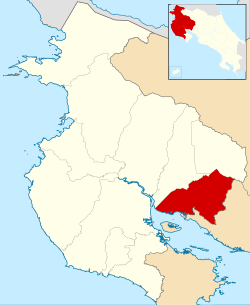Abangares (canton)
10°15′39″N 84°58′11″W / 10.26087°N 84.96964°W
Abangares | |
|---|---|
Cantón | |
 Location of Abangares Canton in Guanacaste Province | |
| Country | Costa Rica |
| Province | Guanacaste |
| Area | |
| • Total | 675.76 km2 (260.91 sq mi) |
| Population (2013) | |
| • Total | 18,895 |
| • Density | 28/km2 (72/sq mi) |
Abangares is the seventh canton in the province of Guanacaste in Costa Rica. The canton covers an area of 675.76 km²,[1] and has a population of 18,895.[2] Its capital city is Las Juntas.
The canton begins on the coastline of the Gulf of Nicoya north of the mouth of the Río Abangares. It widens between the Río Lajas on the northwest and Río Lagartos on the east as it reaches up into the Cordillera de Tilarán.
Districts
The canton of Abangares is subdivided into four districts (distritos):
| District | Population |
|---|---|
| Juntas | 9,803 |
| Sierra | 2,589 |
| San Juan | 1,703 |
| Colorado | 4,800 |
History
The canton was established by law on June 4, 1915.
Gold mines
The Abangares canton is home to the oldest gold mining tradition in Costa Rica, dating back over a century.[3] The first major mining operation was Abangares Mining Company, founded in the Tilarán mountains by U.S. railroad, fruit, and shipping magnate Minor C. Keith.[4]
One of the canton's major modern producers of gold, with silver as a by-product, has been the Tres Hermanos mine, which for many years was operated by El Valiente Ascari S.A., a subsidiary of Ariel Resources Ltd. of Vancouver, British Columbia, Canada.[5] That company filed for insolvency in 2001 and abandoned the operation while still owing its workers two months worth of wages.[3] More than 300 families continue to earn a meager living working through an independent local collective that now operates the mine.[3]
A mining museum at La Sierra de Abangares with artifacts from the boom times of Costa Rican gold mining is a major tourist attraction of the canton.[6]
References
- ^ Instituto Geográfico Nacional (IGN), 2001.
- ^ Estadísticas Vitales 2013 – INEC
- ^ a b c Löding, Torge; Beiersdorf (translator), Dirk M. "Not All Glitters: Corporate gold fever breeds resistance in Central America". Voces Nuestras. Archived from the original on September 16, 2007. Retrieved September 8, 2007.
{{cite news}}:|last2=has generic name (help) - ^ Costa Rica Nature Adventures. "Costa Rica History: Post Independence History". To Enjoy Nature. com. Archived from the original on August 12, 2007. Retrieved September 8, 2007.
{{cite news}}: Unknown parameter|deadurl=ignored (|url-status=suggested) (help) - ^ Doan, David B. (1996). "THE MINERAL INDUSTRY OF COSTA RICA" (PDF). U.S. GEOLOGICAL SURVEY—MINERALS INFORMATION. U.S. Geological Survey, U.S. Department of the Interior. Retrieved 2007-09-08.
{{cite conference}}: Cite has empty unknown parameter:|coauthors=(help); Unknown parameter|booktitle=ignored (|book-title=suggested) (help) - ^ Hutchison, Peter (2001). Costa Rica Handbook: The Travel Guide, First edition. Bath, England: Footprint Handbooks Ltd. p. 223. ISBN 1-903471-06-0.
{{cite book}}: Cite has empty unknown parameter:|coauthors=(help)
External links
